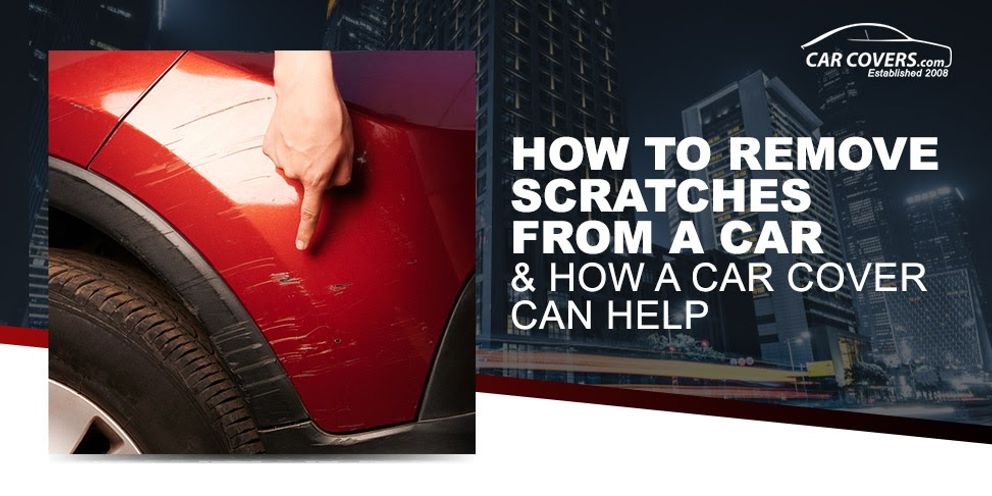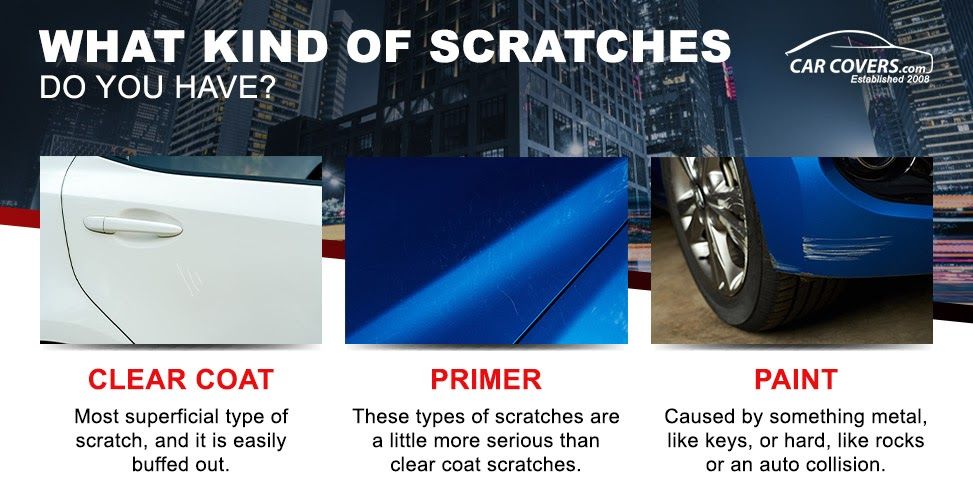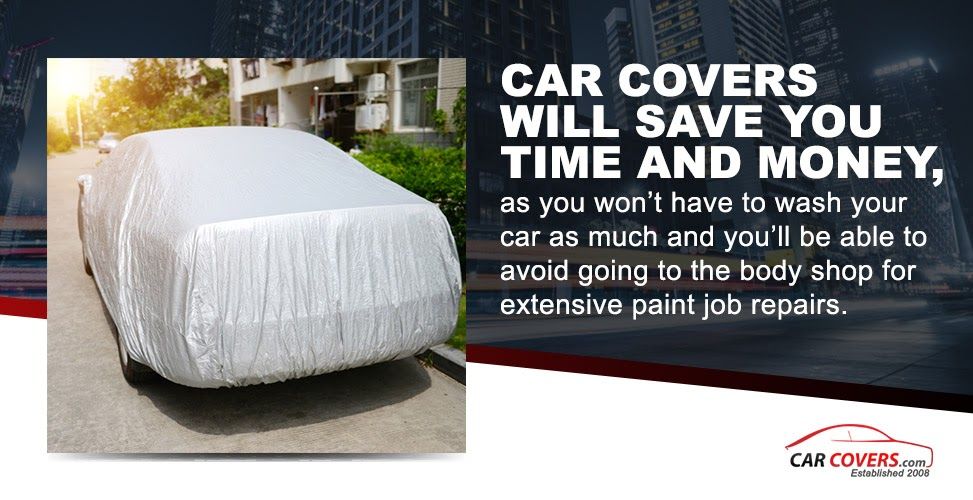
How to Remove Scratches from a Car & How a Car Cover Can Help
Unfortunately, for car owners, scratches on your car are inevitable. Whether from falling tree branches, animals, parking lot bumps, or collisions, scratches can damage your vehicle’s exterior, diminishing its value and increasing the risk of corrosion. However, there are several things you can do to prevent or minimize damage from scratches in the paintwork.
Car covers help you preemptively avoid any long-term damage to your vehicle’s paint job and save you time and money from car washes and minor repairs. There are tons of options in covers these days, including models that are custom fit to your car. Although preventative care, like using a car cover, is the best course of action, you can repair light to deep scratches with some equipment, know-how, and time. Here are some tips on removing scratches from a car and why preventative measures like car covers can prolong your vehicle’s life.
What Kind of Scratches Do You Have?
There are generally three different kinds of scratches from which your car can suffer—paint scratches, primer scratches, and clear coat scratches. The technique you use and the equipment you’ll need will differ from case to case.

- Clear coat scratches – Your car’s exterior has a clear coat applied to the top layer to give your vehicle an extra protection level, as car paint is sensitive to the elements. A scratch on the clear coat is the most superficial type of scratch, and it is easily buffed out. To fix this type of scratch, you won’t need to match paint, but you will need to fix it quickly to diminish the chances that the more-sensitive paint beneath the clear coat will get damaged.
- Primer scratches – The primer coat is directly underneath the clear coat, and these types of scratches are a little more serious than clear coat scratches. The primer coat is another layer of protection for your paint job, maintaining a smooth and even appearance. When you get a scratch in your primer, it can ruin your car’s aesthetic.
- Paint scratches – These types of scratches are the most severe. With paint scratches, you can often see the metal beneath the paint, and this type of damage is caused by something metal, like keys, or hard, like rocks. It can also occur during an auto collision. Car paint scratches have classifications to make it easier to determine which type of repair is needed. The severity levels are 1A, 1B, 2, 3, and 4, with 1A being the least severe and 4 being the most.
There are many remedies for paint scratches, including touch-up kits, candle wax, and nail polish. But before you can make repairs, you need to first clearly assess the damage. Mechanics and automotive experts use their “rule of thumb” when assessing scratch damage. If the pad of your thumb doesn’t catch on the scratch, you may be able to repair it with products you have at your home.

What Equipment Will You Need for Scratch Removal?
The necessary equipment you will need to repair scratches at home consists of:
- Buffer pads and buffer
- Spray bottle filled with water
- Soap
- Rubbing compound (not rubbing alcohol)
- Sandpaper
- Rags or microfiber towel
- Car wax
- Paint that matches your vehicle
Some additional equipment you may find useful:
- Power drill, preferably cordless
- Multiple grit levels of sandpaper
- Multiple grit levels of sandpaper
- Polishing compound
How to Remove Clear Coat or Primer Scratches at Home
- Step 1: Wash the car – Before anything else, you should wash your car. You need a clean surface to minimize damage from dust and debris.
Using a soft sponge and soapy water, pay attention to the area around the scratches, especially in the case of scratches caused by collisions. You’ll be filling in the scratch, in some cases, and you don’t want to trap dirt inside it. - Step 2: Sand the afflicted area – You’ll want to take care with this step. Use the slowest speed and finest grit sandpaper at first, and always sand in the scratch’s direction.
In this step, you are sanding the paint around the scratch down to the scratch level. You only want to go through the clear coat, so go slowly and keep an eye on your progress. Rinse the work area off with water periodically to eliminate dust or debris.
When the finish appears dull or matte, and the scratch is unnoticeable, you’re ready for the next step. Rinse a final time and dry the area with a microfiber cloth. - Step 3: Apply rubbing compound – This compound is made up of an abrasive element suspended in a paste. Using your buffer, apply a small amount of rubbing compound onto the pad and run your drill or polisher at around 1,200 rpm until the area is mildly hazy.
Do not allow the compound to thoroughly dry before progressing to the next step. - Step 4: Polishing compound – Now is the time to buff the area to a high shine. Using your buffer or a cordless drill and pad, buff the area well, moving the tool quickly across the surface and not lingering too long in any one spot.
Using the lowest setting, buff the entire surrounding area of the scratch. To finish, turn your buffer or drill up to 2,000 rpm, concentrate on the scratch, move side to side, and then up and down until all the dullness is gone. - Step 5: Wash and wax – Wash your car one more time, paying particular attention to the area you’ve just repaired. Finish with a thorough wax job to seal in your work.

How Do You Repair Deeper Scratches?
The deeper the scratch, the more complex the repair job. The ideal course of action for deeper scratches would be to avoid them altogether using one of the best car covers. But if it’s already occurred, there are some solutions available to you. If you can see metal, that means that the clear coat, primer, and paint have been entirely stripped away. Before starting repairs, match the paint to your car color exactly. Since the paint has been removed, you will need to apply new paint to make it look seamless.
Protect Your Vehicle With A Car Cover
A factor-paint code is listed on a small metal plaque, either under your hood or on your vehicle’s door sill. Order your paint (or paint pen for touch-ups) and obtain a fine-tipped brush. Once you’ve cleaned and prepared your work area, paint the scratch carefully. If you’re using a paint pen, shake it vigorously before use. If you’re working with a brush, you should maintain a steady hand, to not leave behind any telltale brushstrokes.
Let the paint cure overnight and return the next day to complete your repairs, starting with sanding the area down with very low-grit sandpaper—600 or 1000—backed by a rubber block for support. For this step, you are attempting to sand down any paint you applied the previous day that stands out from the rest of the paint job. After you’ve sanded and cleaned the surface, apply a polishing compound to restore a glossy finish.
With deep scratches, you may have to repeat the paint and compound application one or two more times to get it perfect. Once you’re pleased with the results, you should wax the car at least once a month to seal in the paint and compounds.
Your final step in repairing deep scratches to your car’s exterior is scheduling a clear coat application for your whole vehicle to protect it. Consider buying a custom-fitted car cover to avoid any further damage to your car or your paint job.
Do Home Remedies for Car Scratches Work?
There are plenty of home remedies to remove all three different kinds of scratches from your car’s exterior. Undoubtedly, the one that requires the most skill, time, and patience is a type 4 paint scratch. You may need a touch-up kit and some preliminary lessons before you tackle a type 4. You may have heard of some home remedies for car scratches, from shoe polish to toothpaste. Here’s how they perform when used on car scratches.

- Shoe polish – Polish is an excellent tool in your arsenal for making the scratches stand out while you repair them. After you wash and sand the afflicted area, apply a thin coat of shoe polish so that the scratches definitively stand out. Make sure you use a darker color than your original paint hue. The polish will spread out and fill the scratch, making it stand out and easy to repair.
- Toothpaste – Often used as a budget alternative to rubbing compound, you use the toothpaste to gently scrape off a very thin layer of the paint around the scratch, making the scratch seem imperceptible.
- Nail polish – If sanding and buffing don’t work, you can use nail polish to fill and cover superficial scratches.
- Candle wax – This substance doesn’t get rid of scratches, but it does a great job covering them up. After washing, apply candle wax to the scratched area of your vehicle.
- Super-glue – Since super-glue is clear, it is an excellent filler for scratches. By carefully applying a thin line of super-glue to the scratch, the dried layer levels the scratch with the rest of the paint job.
Why You Should Buy a Car Cover
Instead of fixing scratches after they have happened, act preemptively by using a car cover to protect your car’s exterior from damage from accidents, the elements, wildlife, and other vehicles or people. Car covers come in all price points and sizes. When you shop our collection at CarCovers.com, you will easily find something that fits your lifestyle, budget, and vehicle model. Generally, there are three sizes of car covers to suit your needs—universal, semi-custom, and a fully customized cover.
- Universal cover – These covers are made from low-quality material that fits loosely around your vehicle; a few sizes fit most. Quality manufacturers like CarCovers.com don’t offer these types of covers, as they do not provide adequate protection and may further damage your vehicle.
- Semi-custom – These covers are excellent value. Your vehicle’s height, length, and width are matched with a cover from hundreds of premade ones, so it’s sure to fit within a couple of inches.
- Fully custom – These covers are built to your specific vehicle’s specifications and take about two weeks for the manufacturer to make. They are more expensive than the other two options, but they also contour precisely to your vehicle’s body for a perfect fit.
Even if you keep your car in a garage, you still might sustain scratches or other damage. Dust and debris that settles on the outside of your vehicle can act like sandpaper and damage the paint job. If you have more than one vehicle in your garage, a car cover will protect your car from door dings inflicted by the other vehicle. If you keep your car outside, a quality car cover will save your paint job from the elements, other vehicles and objects, and wildlife. This is especially important if you have an expensive or rare automobile and want to keep it as pristine as possible.

Shop Our Entire Selection of Car Covers
Car covers will save you time and money, as you won’t have to wash your car as much and you’ll be able to avoid going to the body shop for extensive paint job repairs. If you’re eager to make your car’s paint job last longer and keep your vehicle more pristine-looking, a car cover is the solution. However, if you already have a few scratches, you may be able to fix them from the comfort of your own home, depending on their severity.
Shop our selection of outstanding semi-custom and fully custom car covers using our simple to use Cover Finder. Call us at (800) 385-3603 to find out more about the models we have available and how they can protect the exterior of your car from damage.
Updated